Abstract
Fresh lymph-borne (veiled) dendritic cells (L-DC) in the rat are almost totally negative for the interleukin-2 (IL-2) receptor detected by the monoclonal antibody (mAb) MRC OX39. After 16 hr culture more than 90% of L-DC are OX39 positive, and increased levels of expression can be seen within 5 hr culture. In cultures of L-DC and allogeneic lymphocytes. L-DC appear to express the IL-2 receptor more rapidly than lymphocytes. The intensity of labelling of L-DC is variable but maximal levels are similar to those seen on lymphoblasts. Culture in the presence of concanavalin A (Con A)-stimulated spleen cell supernatants or recombinant granulocyte-macrophage colony-stimulating factor (GM-CSF) results in a more rapid and intense expression of the IL-2 receptor by L-DC. L-DC cultured following rigorous T-cell depletion, or derived from athymic rats also express the IL-2 receptor after culture with GM-CSF. Cultured, but not fresh, L-DC bind iodinated recombinant IL-2 in a dose-dependent manner and binding is inhibited by excess unlabelled ligand. The amount of IL-2 bound varies but maximal amounts are similar to those bound by lymphoblasts. Following intravenous endotoxin injection, a large proportion of freshly collected L-DC express the IL-2 receptor and the number of L-DC released into the lymph is increased. An antibody to the IL-2 receptor which blocks an allogeneic MLR has no effect on a xenogeneic MLR using rat L-DC as stimulators and mouse lymphocytes as responders.
Full text
PDF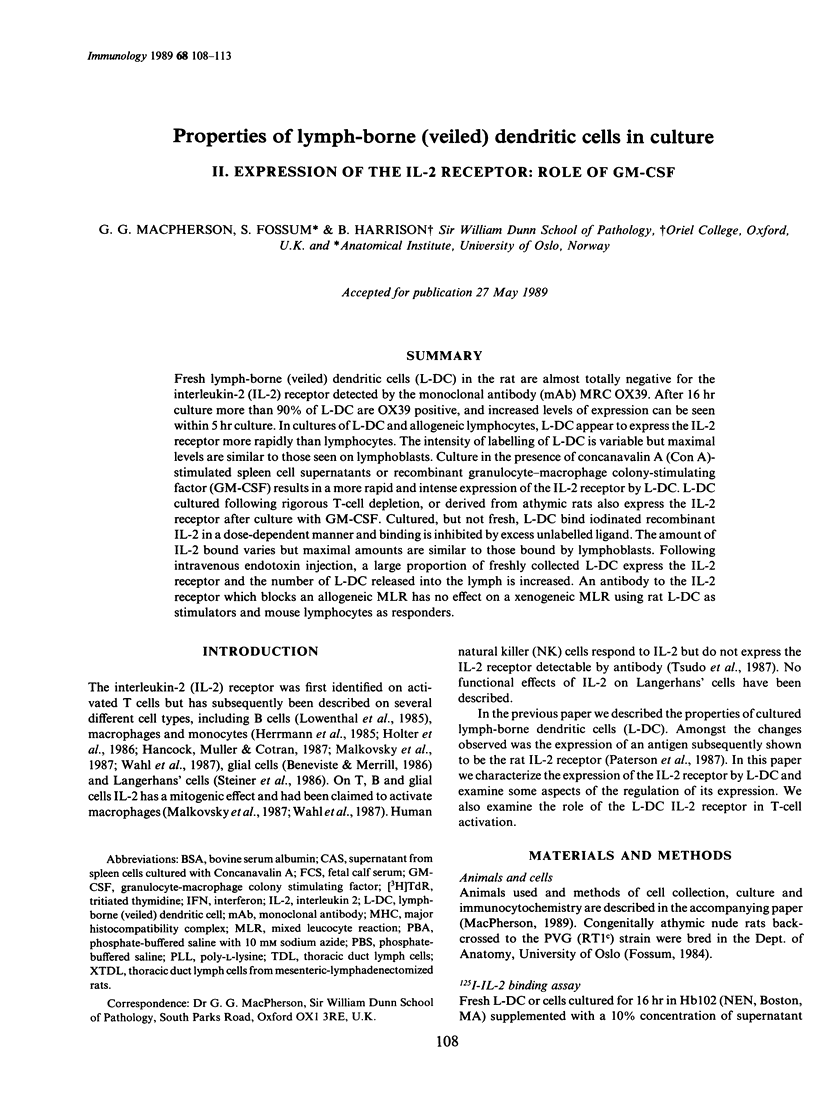
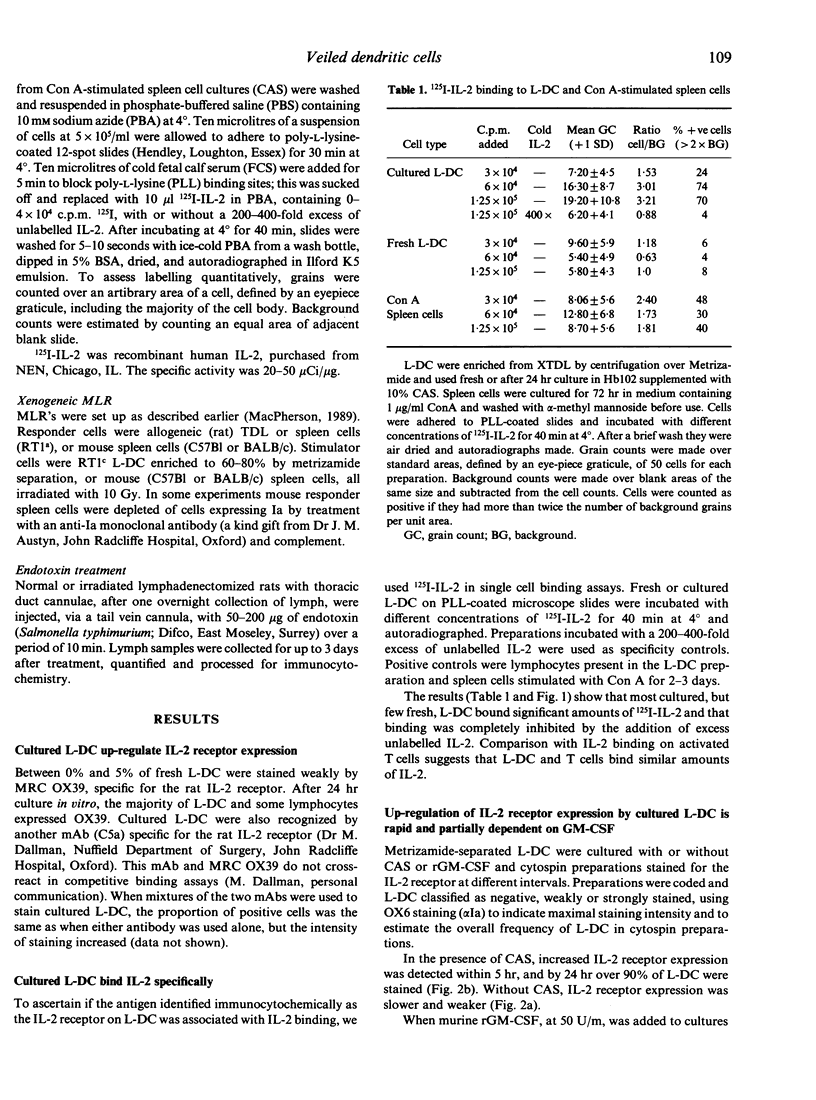
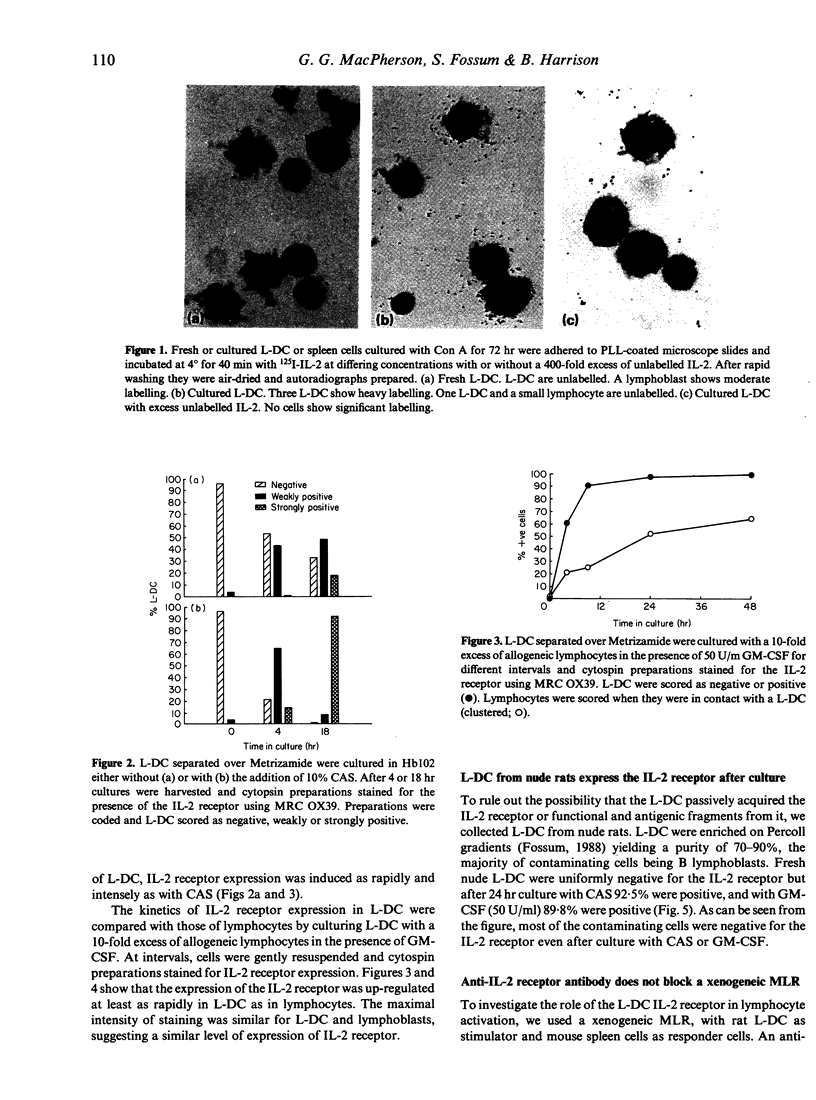
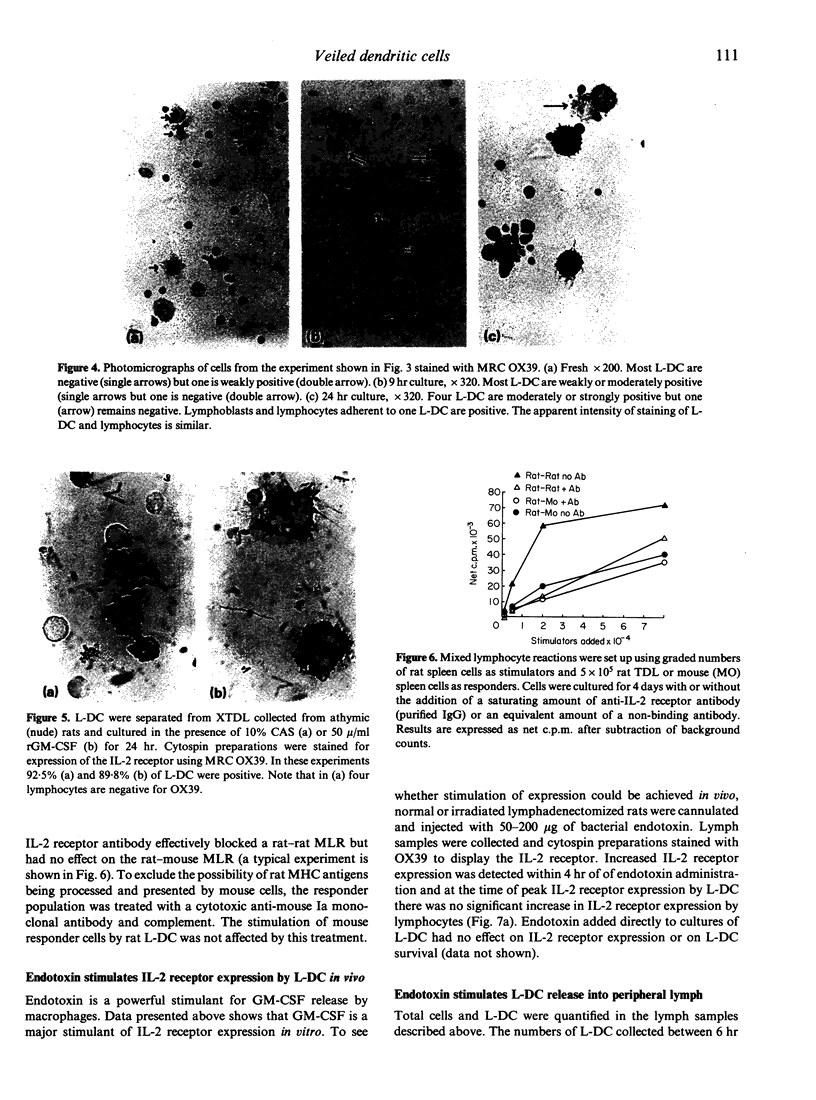
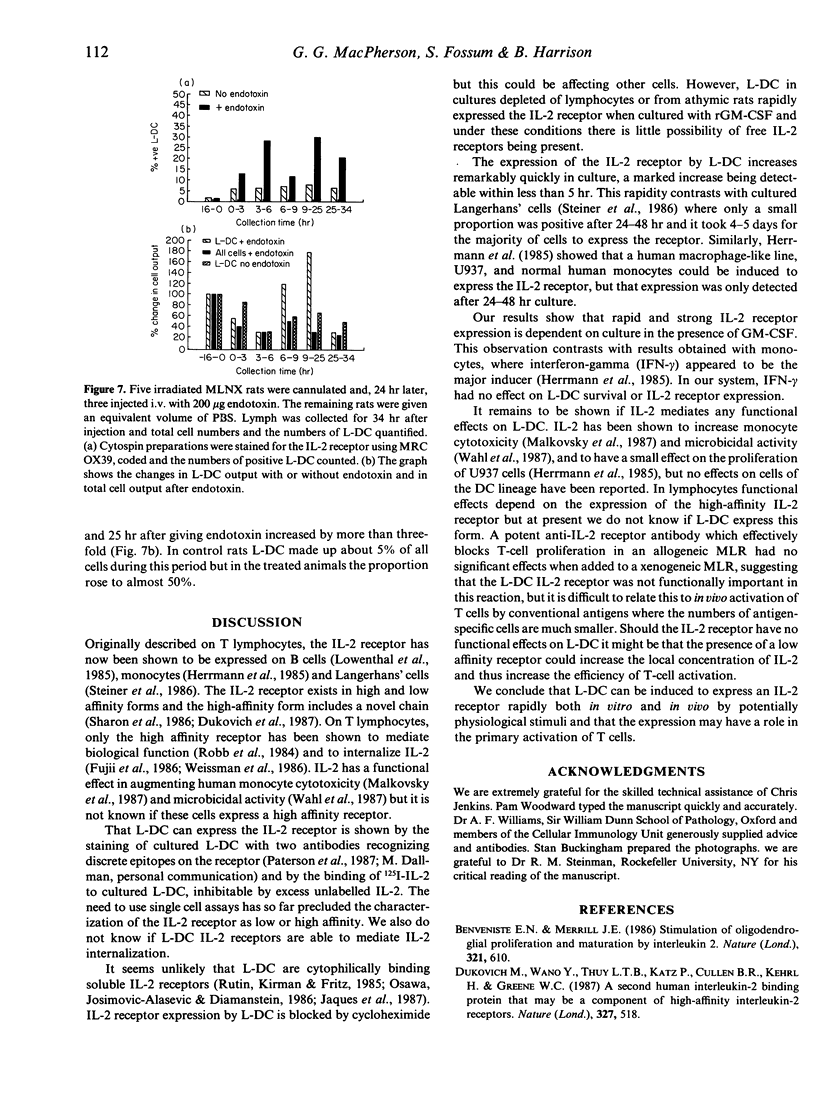
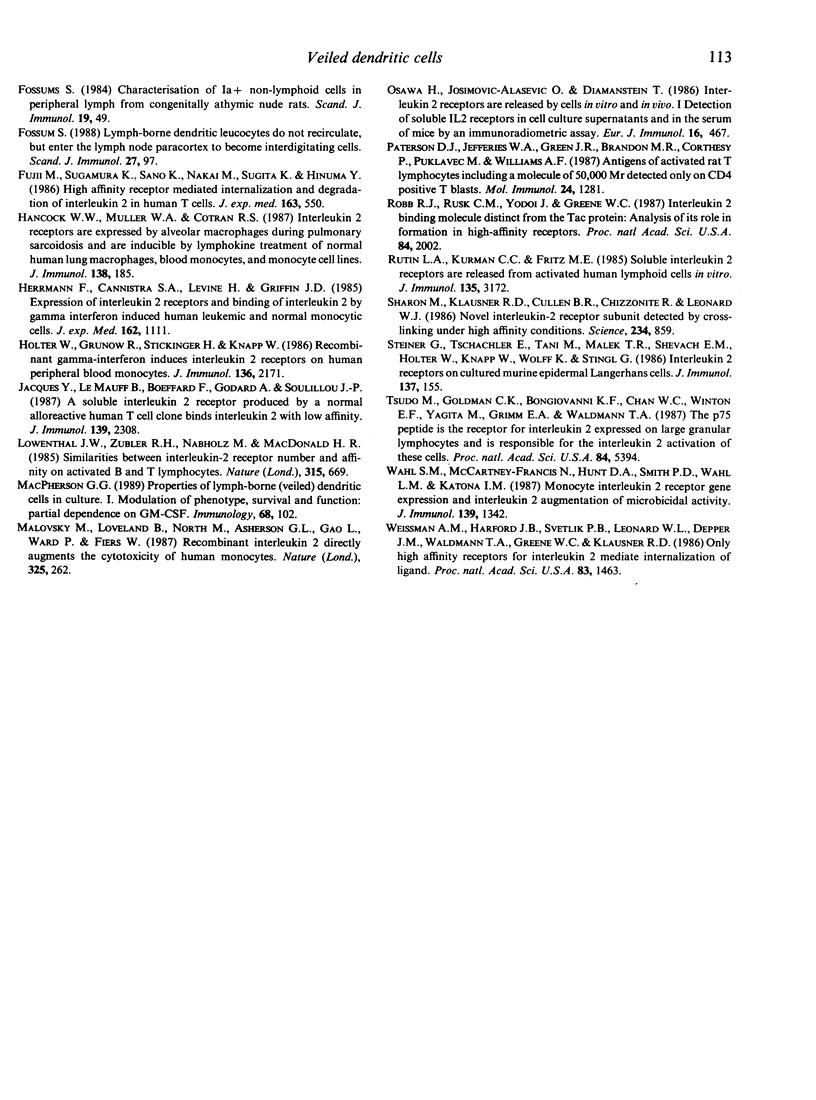
Images in this article
Selected References
These references are in PubMed. This may not be the complete list of references from this article.
- Benveniste E. N., Merrill J. E. Stimulation of oligodendroglial proliferation and maturation by interleukin-2. Nature. 1986 Jun 5;321(6070):610–613. doi: 10.1038/321610a0. [DOI] [PubMed] [Google Scholar]
- Dukovich M., Wano Y., Le thi Bich Thuy, Katz P., Cullen B. R., Kehrl J. H., Greene W. C. A second human interleukin-2 binding protein that may be a component of high-affinity interleukin-2 receptors. Nature. 1987 Jun 11;327(6122):518–522. doi: 10.1038/327518a0. [DOI] [PubMed] [Google Scholar]
- Fossum S. Characterization of Ia+ non-lymphoid cells in peripheral lymph from congenitally athymic nude rats. Scand J Immunol. 1984 Jan;19(1):49–61. doi: 10.1111/j.1365-3083.1984.tb00899.x. [DOI] [PubMed] [Google Scholar]
- Fossum S. Lymph-borne dendritic leucocytes do not recirculate, but enter the lymph node paracortex to become interdigitating cells. Scand J Immunol. 1988 Jan;27(1):97–105. doi: 10.1111/j.1365-3083.1988.tb02326.x. [DOI] [PubMed] [Google Scholar]
- Fujii M., Sugamura K., Sano K., Nakai M., Sugita K., Hinuma Y. High-affinity receptor-mediated internalization and degradation of interleukin 2 in human T cells. J Exp Med. 1986 Mar 1;163(3):550–562. doi: 10.1084/jem.163.3.550. [DOI] [PMC free article] [PubMed] [Google Scholar]
- Hancock W. W., Muller W. A., Cotran R. S. Interleukin 2 receptors are expressed by alveolar macrophages during pulmonary sarcoidosis and are inducible by lymphokine treatment of normal human lung macrophages, blood monocytes, and monocyte cell lines. J Immunol. 1987 Jan 1;138(1):185–191. [PubMed] [Google Scholar]
- Herrmann F., Cannistra S. A., Levine H., Griffin J. D. Expression of interleukin 2 receptors and binding of interleukin 2 by gamma interferon-induced human leukemic and normal monocytic cells. J Exp Med. 1985 Sep 1;162(3):1111–1116. doi: 10.1084/jem.162.3.1111. [DOI] [PMC free article] [PubMed] [Google Scholar]
- Holter W., Grunow R., Stockinger H., Knapp W. Recombinant interferon-gamma induces interleukin 2 receptors on human peripheral blood monocytes. J Immunol. 1986 Mar 15;136(6):2171–2175. [PubMed] [Google Scholar]
- Jacques Y., Le Mauff B., Boeffard F., Godard A., Soulillou J. P. A soluble interleukin 2 receptor produced by a normal alloreactive human T cell clone binds interleukin 2 with low affinity. J Immunol. 1987 Oct 1;139(7):2308–2316. [PubMed] [Google Scholar]
- Lowenthal J. W., Zubler R. H., Nabholz M., MacDonald H. R. Similarities between interleukin-2 receptor number and affinity on activated B and T lymphocytes. Nature. 1985 Jun 20;315(6021):669–672. doi: 10.1038/315669a0. [DOI] [PubMed] [Google Scholar]
- MacPherson G. G. Properties of lymph-borne (veiled) dendritic cells in culture. I. Modulation of phenotype, survival and function: partial dependence on GM-CSF. Immunology. 1989 Sep;68(1):102–107. [PMC free article] [PubMed] [Google Scholar]
- Malkovský M., Loveland B., North M., Asherson G. L., Gao L., Ward P., Fiers W. Recombinant interleukin-2 directly augments the cytotoxicity of human monocytes. Nature. 1987 Jan 15;325(6101):262–265. doi: 10.1038/325262a0. [DOI] [PubMed] [Google Scholar]
- Osawa H., Josimovic-Alasevic O., Diamantstein T. Interleukin 2 receptors are released by cells in vitro and in vivo. I. Detection of soluble IL 2 receptors in cell culture supernatants and in the serum of mice by an immunoradiometric assay. Eur J Immunol. 1986 Apr;16(4):467–469. doi: 10.1002/eji.1830160426. [DOI] [PubMed] [Google Scholar]
- Paterson D. J., Jefferies W. A., Green J. R., Brandon M. R., Corthesy P., Puklavec M., Williams A. F. Antigens of activated rat T lymphocytes including a molecule of 50,000 Mr detected only on CD4 positive T blasts. Mol Immunol. 1987 Dec;24(12):1281–1290. doi: 10.1016/0161-5890(87)90122-2. [DOI] [PubMed] [Google Scholar]
- Robb R. J., Rusk C. M., Yodoi J., Greene W. C. Interleukin 2 binding molecule distinct from the Tac protein: analysis of its role in formation of high-affinity receptors. Proc Natl Acad Sci U S A. 1987 Apr;84(7):2002–2006. doi: 10.1073/pnas.84.7.2002. [DOI] [PMC free article] [PubMed] [Google Scholar]
- Rubin L. A., Kurman C. C., Fritz M. E., Biddison W. E., Boutin B., Yarchoan R., Nelson D. L. Soluble interleukin 2 receptors are released from activated human lymphoid cells in vitro. J Immunol. 1985 Nov;135(5):3172–3177. [PubMed] [Google Scholar]
- Sharon M., Klausner R. D., Cullen B. R., Chizzonite R., Leonard W. J. Novel interleukin-2 receptor subunit detected by cross-linking under high-affinity conditions. Science. 1986 Nov 14;234(4778):859–863. doi: 10.1126/science.3095922. [DOI] [PubMed] [Google Scholar]
- Steiner G., Tschachler E., Tani M., Malek T. R., Shevach E. M., Holter W., Knapp W., Wolff K., Stingl G. Interleukin 2 receptors on cultured murine epidermal Langerhans cells. J Immunol. 1986 Jul 1;137(1):155–159. [PubMed] [Google Scholar]
- Tsudo M., Goldman C. K., Bongiovanni K. F., Chan W. C., Winton E. F., Yagita M., Grimm E. A., Waldmann T. A. The p75 peptide is the receptor for interleukin 2 expressed on large granular lymphocytes and is responsible for the interleukin 2 activation of these cells. Proc Natl Acad Sci U S A. 1987 Aug;84(15):5394–5398. doi: 10.1073/pnas.84.15.5394. [DOI] [PMC free article] [PubMed] [Google Scholar]
- Wahl S. M., McCartney-Francis N., Hunt D. A., Smith P. D., Wahl L. M., Katona I. M. Monocyte interleukin 2 receptor gene expression and interleukin 2 augmentation of microbicidal activity. J Immunol. 1987 Aug 15;139(4):1342–1347. [PubMed] [Google Scholar]
- Weissman A. M., Harford J. B., Svetlik P. B., Leonard W. L., Depper J. M., Waldmann T. A., Greene W. C., Klausner R. D. Only high-affinity receptors for interleukin 2 mediate internalization of ligand. Proc Natl Acad Sci U S A. 1986 Mar;83(5):1463–1466. doi: 10.1073/pnas.83.5.1463. [DOI] [PMC free article] [PubMed] [Google Scholar]





